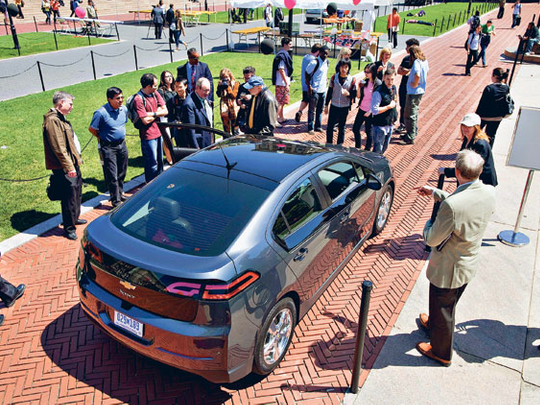
Boston: Yet Ming Chiang relishes his 32 kilometre drive to work. His hybrid car gets more than 160 kilometres per gallon, recharges by plugging into a regular wall outlet and purrs so quietly that it's his favourite place for making important phone calls.
But what makes Chiang's ordinary-looking beige Toyota Prius even more special is that it's powered by a breakthrough battery that he invented and is working to turn into the kind of high-tech, green, "Made in America" product that many see as the key to the nation's econ-omic future.
Safer and longer-lasting than conventional lithium-ion car batteries, the 52-year old MIT professor's invention packs 600 cells into a case the size of an aeroplane carry-on bag. His technology has transformed the batteries used in many cordless power tools. So why are Chiang and his company, A123 Systems, having trouble moving to full-scale commercial production and creating thousands of new American jobs with his better mousetrap?
Rebirth
The answer is a story of the obstacles to a rebirth of US manufacturing, and of the tantalising possibilities if such a rebirth could be achieved.
For Chiang's company has one foot in China and the other in the US, reflecting the forces that drive manufacturers overseas and the potential for a renaissance at home.
The obstacles here are rooted in the sad history of manufacturing's decline in the United States: Despite the promise of Chiang's batteries, many on Wall Street and in Silicon Valley were incredulous when he and other leaders at A123 asked for capital to build factories in America — Asia, yes, but Michigan, why would you want to?
Even more daunting, nearly all of the world's battery manufacturing industry is in Asia, where plants can be built faster and supplies and equipment are much easier to get than in the United States. These days, it's hard to find Americans who even know how to build a battery factory. That's why A123 had to give in and build its first plants in China, where the company could move into production quickly to show auto industry customers that it could deliver on future contracts.
"Without question, we would rather have done it all in the US," said Chiang, who left Taiwan as a six-year-old with his family, earned degrees at MIT and has been a materials science professor there since the mid-1980s.
"I'm an American citizen. We're an American company. It's an American-born technology."
Despite the obstacles, A123 and other advanced battery producers are building plants in Michigan and other states, thanks to massive government support that has offset Wall Street's scepticism and should help domestic producers narrow cost disadvantages with Asian rivals.
A123 is getting $250 million (Dh918 million) in aid from the Obama administration's stimulus programme as well as tax incentives from Michigan.
Its first US plant opens in June in an abandoned brick building near Detroit that once made VHS tapes for Disney. That achievement is a testament to American inventiveness, still-flourishing entrepreneurism and a belated conclusion on the part of government that making things in America is crucial to the nation's economic future.
"Too often we've done the innovation and we've outsourced the manufacturing," said Matt Rogers, a senior advisor to Secretary of Energy Steven Chu.
"That's where A123 becomes important." Such talk challenges the long-held view that the US economy could continue to prosper even when manufacturing moved overseas, so long as Americans churned out the best research and ideas for high-value products. But recent experience has suggested that big manufacturing complexes devoted to a single industry, such as those in China, act as magnets for research-and-development facilities too. Chiang, who wears big silver-rimmed glasses and smiles easily, won an initial $100,000 grant from the Energy Department in late 2001. It helped pay graduate students who, working in an MIT lab on a June night in 2002, suddenly shouted the battery developer's equivalent of eureka: "Higher power!"












